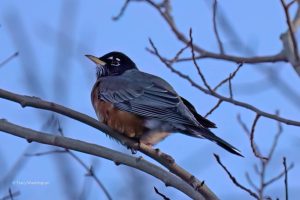
Someone once described a day in the life of a robin as follows:
Run, run, run, STOP.
Run, run, run, STOP.
Run, run, run, STOP.
Run, run, run, STOP.
There’s much contentment found in sitting quietly and watching robins. They’re keen worm finders, tilting their heads just so, to focus one eye on wormholes in the earth, looking for occupants.
Sometimes they’ll follow us as we mow lawns, enjoying the easier access to worms and bugs in the shorter grass. And gardeners often chuckle as robins patiently wait for fresh soil turns to liberate a veritable buffet of invertebrates. They love gathering mud for nest-building followed by a good long splash in the nearest puddle to clean up.
These ubiquitous birds of North America mean many things to many people at different times of the year.
The first robin’s song heard, for many is a joyous moment declaring spring is upon us. Even though many robins over-winter in many parts of Canada (as long as food is available), they’re silent. And no coincidence that the mnemonic for its primary song is Cheerio, cheeriooo! They are often singing before dawn, sometimes as early as 3 a.m., and are really the only alarm clocks we need in spring.
As they build nests close to our porches and patios, we often get a window into the incubation period and, later, feeding of nestlings, mouths agape.
The American Robin’s Latin name, turdus migratorius, literally translated, is migratory thrush. As a member of the thrush family, it comes by its beautiful song honestly. Any hiker in boreal forests will recognize the flute-like voices of the hermit and wood thrushes, and robins certainly have a bit of that in their songs.
Their migration patterns are not highly programmed, like many birds who head straight for Mexico and southern climes. Robins adapt their diet and travel solely for food sources as required. After a summer of worms and insects, in winter, they become what’s called frugivores, eating berries and fruit left on trees.
An old saw from Pennsylvania claims that if you want to see robins in winter, go up the mountain and kick the bushes. According to Sally Roth, author of Bird-by-Bird Gardening, it’s true! She found herself on a mountain road and pulled over to walk the shoulder. Her presence flushed out a flock of robins who had been foraging in the undergrowth – like any other thrush, of course!
And some say if the first robin you see is up in a tree, good fortune will come your way. So as any seasoned bird-watcher will tell you, keep looking up! Happy birding, all. ~
